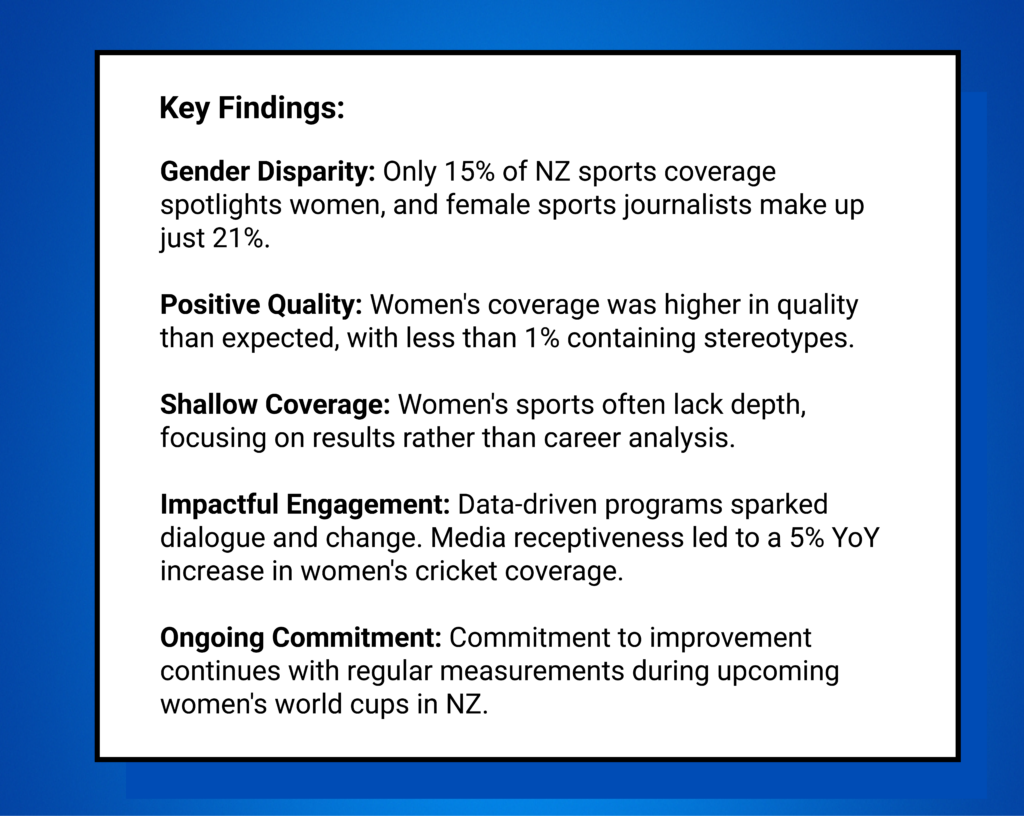Blog
The fundamentals of stakeholder strategy
A practical guide to tailored stakeholder management, offering strategies and tools to identify, map, and nurture relationships.
The sports media landscape has long grappled with gender imbalance in coverage, limiting the representation of women’s achievements and stories. A reference group put together by Sport New Zealand, including sports leaders and academics, concluded that the largest driver of visibility for sport is media coverage. Sport New Zealand recognised the need for a transformative change and commissioned Isentia’s Insights team to produce an ongoing annual report delving into these critical issues. The challenge was to uncover actionable insights that could reshape the narrative around women in sports.
Leveraging its extensive media monitoring and analytics expertise, Isentia’s Insights team worked closely with Sport New Zealand to conduct a comprehensive study. The aim was to understand the current state of gender representation in sports media, analysing 100 media items per day from 1 January – 31 December 2022 and identify areas of improvement. By analysing a vast array of media data, the Insights team pinpointed trends, disparities, and potential strategies for change.
One of the largest of its type, this study analysed over 42,000 media items in its first year, using human-driven media analysis to examine how athletes, sports leaders, and teams are portrayed in news media. The research resulted in a meticulously detailed report, dissecting media coverage of women in sports. Isentia’s Insights team examined coverage nuances to highlight key findings like the surge in women’s sports coverage due to New Zealand hosting events, and the evolution of focus areas between male and female athletes. The report serves as a powerful resource for understanding media dynamics and the impact of sporting events on gender balance.
Compelling insights that have ignited a paradigm shift in the sports media landscape. The report underscored the remarkable 28% surge in women’s sports coverage and its correlation with hosting events in New Zealand. This data-driven approach can empower stakeholders, brands, and media networks to make informed decisions. The insights are a catalyst for fostering inclusivity, driving gender equality, and refining communication strategies within the industry.

This commissioned work between Isentia’s Insights team and Sport New Zealand serves as a testament to the power of data-driven research in fostering change. By shedding light on gender disparities in sports media, the case study exemplifies how media monitoring and analytics can lead to meaningful transformation, shaping a new era of balanced and inclusive sports coverage.

Curious about the transformative power of insights and research for your organisation? Let’s chat! Reach out to explore how data-driven strategies, like those that elevated Sport New Zealand’s impact, can reshape your success story. Connect with us today!
Loren is an experienced marketing professional who translates data and insights using Isentia solutions into trends and research, bringing clients closer to the benefits of audience intelligence. Loren thrives on introducing the groundbreaking ways in which data and insights can help a brand or organisation, enabling them to exceed their strategic objectives and goals.
A practical guide to tailored stakeholder management, offering strategies and tools to identify, map, and nurture relationships.
Across the communications landscape, teams are being asked to do more with less, while staying aligned, responsive and compliant in the face of complex and often shifting stakeholder demands. In that environment, how we track, report and manage our relationships really matters. In too many organisations, relationship management is still built around tools designed for […]
Get in touch or request a demo.